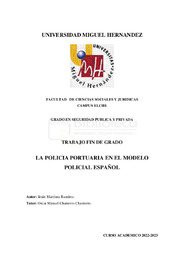Resumen :
La policía portuaria es un cuerpo algo desconocido para la sociedad a diferencia del Cuerpo Nacional de Policía (en adelante CNP) o la Guardia Civil (en adelante GC), presentes en todo el territorio nacional, pues su jurisdicción y competencia solo se limita en la zona de dominio público portuario.
Tal y como se articula en la Constitución Española (en adelante CE), el modelo policial en España se regula a través de la Ley Orgánica 2/1986 de 13 de marzo de Fuerzas y Cuerpos de Seguridad (en adelante LOFCS). Existen diferentes cuerpos policiales, clasificándose en estatales, autonómicos y locales, atendiendo a su área competencial funcional y territorial, todos ellos regulados en la LOFCS.
En este trabajo, se llevará a cabo un desarrollo de la Policía Portuaria empezando por sus antecedentes históricos, los cuerpos de Policía Portuaria existentes en España y a nivel internacional. Los diferentes marcos normativos por los cuales se rige, las funciones que realizan en la actualidad y demás competencias.
Se pondrán de manifiesto las deficiencias organizativas, funcionales y vacíos legales de la Policía Portuaria Estatal y Autonómica, realizando una comparativa con el resto de FCS y sus colaboraciones en materia portuaria. Se expondrán una serie de modificaciones y mejoras en dicho modelo policial portuario, planteándose una propuesta de reestructuración estable y organizado, permitiendo prestar un mejor servicio a la ciudadanía y consolidar una unificación policial a nivel portuario sin precedentes.
The port police is a body that is somewhat unknown to society, unlike the National Police Force (hereinafter CNP) or the Civil Guard (hereinafter GC), present throughout the national territory, since their jurisdiction and competence is only limited in the port public domain area.
As articulated in the Spanish Constitution (hereinafter EC), the police model in Spain is regulated by Organic Law 2/1986 of March 13 on Security Forces and Corps (hereinafter LOFCS). There are different police forces, classified as state, regional and local, according to their functional and territorial area of competence, all of them regulated in the LOFCS.
In this work, a development of the Port Police will be carried out starting with its historical background, the existing Port Police forces in Spain and internationally. The different regulatory frameworks by which it is governed, the functions they currently perform and other powers.The organizational and functional deficiencies and legal gaps of the State and Autonomous Port Police will be revealed, making a comparison with the rest of the FCS and their collaborations in port matters.
A series of modifications and improvements in said port police model will be exposed, considering a stable and organized restructuring proposal, allowing a better service to be provided to the public and consolidating an unprecedented police unification at the port level.
|
 La licencia se describe como: Atribución-NonComercial-NoDerivada 4.0 Internacional.
La licencia se describe como: Atribución-NonComercial-NoDerivada 4.0 Internacional.
.png)
